Ducati rejects 'winglets are dangerous' argument

Gigi Dall'Igna has challenged claims that MotoGP winglets are inherently dangerous, suggesting moves to ban the technology on safety grounds are more of 'a pretext' to halt Ducati's aerodynamic advantage.
However the Ducati Corse general manager is 'willing to improve the current regulations', calling for 'intellectual honesty and common sense... so we can continue to work on aerodynamics with clearer and more detailed regulations'.
Ducati pioneered the latest generation of winglets on its 2015 machine, the first complete Desmosedici overseen by Dall'Igna. The Italian factory has been at the forefront of winglet technology ever since, its ongoing investment clear to see through frequent design evolutions.
Six months after the Ducati winglet debut, Yamaha unveiled its version at the 2015 Misano round. Honda was next, albeit not until this year's Qatar test. Suzuki and Aprilia finally made it a clean sweep of all five manufacturers last weekend at Jerez.
But at the same time rumours were circulating that winglets could soon be banned, with the manufacturers' association (MSMA) meeting to try and agree on a proposal for the future of such devices.
With winglets clearly legal under the present rules, safety is the key factor in terms of any immediate rule amendments.
Those in favour of scrapping the technology have been quick to highlight contact between Andrea Iannone's left winglet and Marc Marquez at the start of the Argentine Grand Prix.
Safety issues raised by Argentina race: 2) Iannone wing makes contact with Marquez #ArgentinaGP #MotoGP pic.twitter.com/CnUoQdBd68-- Crash.net MotoGP (@crash_motogp) April 5, 2016
"In the case of Iannone's and Marquez's clash at the first corner of the Argentina GP, the left winglet of our bike broke off and Marquez didn't suffer any damage or a different problem to what could have happened in a normal contact of this kind. And there are certainly other parts of a bike (the bars and the foot-pegs for example) that can cause problems in case of contact.
"It is also true however that everything can be improved and for this reason we will put forward our proposal for a ruling on the winglets, with a view to further improving the safety of the bikes."
 |
| Left winglet missing from Iannone's Ducati after earlier contact with Marquez in Argentina MotoGP race. |
The main purpose of the winglets is to generate downforce at the front of the bike during acceleration, thus reducing the amount of wheelie without needing to cut engine output.
"The winglets are useful to reduce the tendency of the bikes to wheelie and I believe that we all agree when we state that a bike that keeps its front wheel down on the track under acceleration is safer than one with its wheel in the air," Dall'Igna added.
"As I have said, we are willing to improve the current regulations, in view of greater safety, but we cannot accept that an incident without any serious consequences is taken as a pretext to try and bring a halt to development in a field which Ducati began before anyone else, in full compliance with existing regulations, and which as a result has given us an advantage over some of our competitors.
"I hope that intellectual honesty and common sense will prevail so we can continue to work on aerodynamics with clearer and more detailed regulations."
With Ducati strongly opposed to a ban on winglets (as recently introduced for Moto2 and Moto3), restrictions on the size, shape and location of the devices is the most likely outcome of the MSMA discussions - assuming the manufacturers can agree on a proposal.












